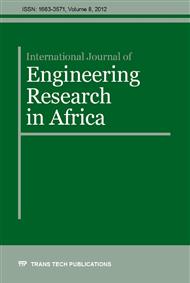p.1
p.17
p.37
p.47
p.55
p.73
p.83
Reliability Studies on Timber Data from Nigerian Grown Iroko Tree (Chlorophora excelsa) as Bridge Beam Material
Abstract:
This paper provides the results of structural reliability analysis carried out on the data of Nigerian grown Iroko tree (Chlorophora excelsa), to ascertain its structural performance as timber bridge beams. Five pieces of 50mm x 75mm x 3600mm of Nigerian grown Iroko hardwood were bought, seasoned naturally and 200 pieces of samples were prepared for determination of their strength properties, (which include bending strength parallel to grain, tensile strength parallel to grain, compressive strength parallel to grain, compressive strength perpendicular to grain and shear strength parallel to grain) at a moisture content of 18%, in accordance with the British Standard BS 373 of 1957. Statistical analysis was carried out using the strength properties for determination of mean, standard deviation, coefficient of variations, confidence limits and Chi-Square goodness of fits. Structural analysis and design of a timber bridge beam using the determined data from the Nigerian grown Iroko timber, in accordance with BS 5268 were carried out under the Ultimate Limit State of loading (ULSL). Reliability analysis was carried out to ascertain its level of safety using First-Order Reliability Method (FORM). Sensitivity analysis was also carried out by varying the depth of beam, imposed live load, breadth of the beam, unit weight of the Iroko timber, span of the beam as well as the end bearing length. The result revealed that the Nigerian grown Iroko timber is a satisfactory structural material for timber bridge beams at depth of 400mm, breadth of 150mm and span of 5000mm under the ULSL. The probabilities of failure of the Nigerian grown Iroko timber bridge beam in bending, shear, compression and deflection are respectively, under the specified conditions of loading.
Info:
Periodical:
Pages:
17-35
Citation:
Online since:
December 2012
Authors:
Price:
Сopyright:
© 2012 Trans Tech Publications Ltd. All Rights Reserved
Share:
Citation:


